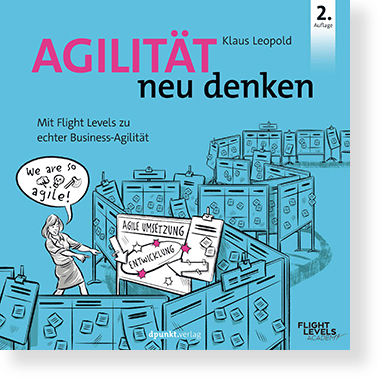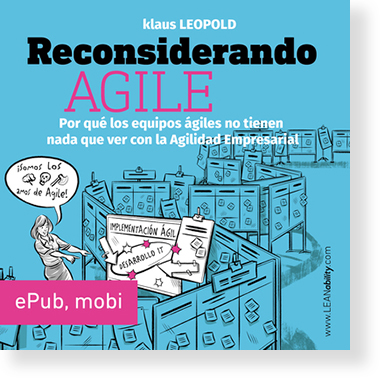
HOME | BOOKS | AUTHORS | GENRES | CONTACT
Klaus Leopold - Rethinking Agile, revised and extended second edition
Why Agile Teams Have Nothing To Do With Business Agility
Jump to: Book details | About the author | Recommendations | Table of contents | Published translations
 |
If this situation seems familiar, you should read this story about a company that prepared their agile transition in exemplary fashion: 600 employees reorganized into cross-functional teams, their work visualized and practically perfect Standups and Retrospectives held. The result: Time-to-Market for the products became worse – and not a trace of business agility.
Klaus Leopold shows in words and illustrations what goes wrong with many agile transformations and why the desired improvements fail to materialize. You also learn how to get out of a dead end and what can be done with the help of the Flight Levels thinking model to avoid a dead end in the first place and to achieve the goal of "more business agility" after all.
In the 2nd edition you will find an expanded and updated explanation of the Flight Levels Thinking Model. With this model, Klaus Leopold shows companies worldwide how to avoid the traps of local optimization and scaling blueprints and where the levers for real, individual business agility are hidden instead.
This much in advance: Don't start agilizing teams - it saves nerves and a lot of money!
|
 |
Dr. Klaus Leopold is a computer scientist and, as a top-management consultant, he has been helping companies worldwide to move agile in the market for more than ten years. Klaus developed the Flight Levels model because he repeatedly observed a phenomenon in agile transformations: Teams are "agilized", but these local optimizations do not lead to an agile business. In his book Rethinking Agile, he shows how to avoid this error from the very beginning and what makes for real business agility when aligning an organization with the market's demands. In his early years in the Agile community, Klaus was intensively involved with Kanban. He wrote two standard works on the subject with Practical Kanban and Kanban Change Leadership. Today, his focus is on offering a way for organizations to find their individual path to more business agility with the Flight Levels model.
He shares his thoughts, experiences and insights on the blog of www.leanability.com and under @klausleopold on Twitter.
'The book is convincing, because the Flight Levels model relies on collective intelligence instead of copy-paste thinking when finding individual solutions for companies.' – Dr. Bernhard Höhne, Roche
'Everything agile, everything good, right? Exactly not! A refreshingly honest and attractively illustrated view of things, in which one often recognizes the stumbling blocks of one's own work in an agile company. Including an ingenious recipe for how to do it better: the Flight Levels model.' – Gabriela Bimüller, ING-DiBa
Foreword
Preface
Acknowledgements
Part 1: The Problem
Part 2: The Causes
Part 3: The Solution
Part 4: The Result
Part 5: Flight Levels
References
 |
 German translation published by dPunkt Verlag:
German translation published by dPunkt Verlag:
Alle agilen Register sind gezogen und trotzdem kommen neue Produkte nicht schneller auf den Markt? Die Konkurrenz überholt links und rechts, während die eigenen Innovationsprozesse ins Stocken geraten?
Wenn Ihnen diese Situation bekannt vorkommt, dann lesen Sie die Geschichte eines Unternehmens, das die agile Transformation mustergültig vorbereitet hat. 600 Mitarbeiterinnen und Mitarbeitern wurde ein agiles Mindset antrainiert, crossfunktionale Teams und die schönsten Boards installiert, Abhängigkeiten konsequent eliminiert und Standup-Meetings streng getimeboxt. Mit dem Ergebnis: Die Time-to-Market der Produkte wurde schlechter – von Business-Agilität keine Spur.
Klaus Leopold zeigt in Wort und Illustration, was bei vielen agilen Transformationen falsch läuft und warum die ersehnten Verbesserungen ausbleiben. Sie erfahren aber auch, wie man aus der Sackgasse wieder herauskommt und was Sie mithilfe des Flight-Levels-Denkmodells tun können, um erst gar nicht in die Sackgasse einzubiegen und das Ziel »mehr Business-Agilität« doch noch zu erreichen.
 |
 Spanish translation published by LEANability Press:
Spanish translation published by LEANability Press:
Este libro describe una transición ágil en una empresa en la que estaban involucradas 600 personas. El objetivo descrito consistía en reducir el Time-to-Market de las iniciativas para poder reaccionar con más velocidad ante las necesidades de los clientes y conseguir así que aumentase la agilidad empresarial.
Para conseguirlo se llevó a cabo una reorganización. Todos los equipos se establecieron de forma multidisciplinar con el fin de estar al tanto de todo el conocimiento necesario para el desarrollo en equipo. Asimismo, los equipos se organizaron por productos para eliminar dependencias. La visualización del trabajo, las reuniones standups y las retrospectivas completaron la transición ágil. Lo único que faltó fue la esperada mejora. El libro muestra la razón por la que no se llegó a ningún progreso, así como lo que, sin embargo, se hizo para mejorar la situación y alcanzar el objetivo "más agilidad empresarial". Los/as lectores/as aprenderán también cómo abordar una transición ágil de esta magnitud para no caer en la desagradable situación de no ver progreso. Lo dicho: no comenzar a nivel de equipo - ¡ello no solo ahorra nervios sino también mucho dinero!
 |
 Polish translation published by LEANability Press:
Polish translation published by LEANability Press:
Książka opowiada historię firmy, która przeprowadza transformację Agile dla swoich 600 pracowników. Mimo podręcznikowego wdrożenia zwinnych metod i narzędzi pracy, czas dostarczania produktu na rynek okazał się być dłuższy niż przed transformacją.
Dlaczego nie udało się osiągnąć wyznaczonego celu? Przecież zwinne zespoły działają szybciej i efektywniej! Brzmi znajomo? Autor wskaże na powyższym przykładzie co poszło nie tak i na co warto zwrócić uwagę przed wprowadzaniem zmian. Poznasz model Flight Level i dowiesz się, czym jest prawdziwa zwinność biznesowa.
 |
 Portuguese translation published by LEANability Press:
Portuguese translation published by LEANability Press:
Todas as cartas ágeis foram puxadas, porém, novos produtos ainda não chegam mais rápido ao mercado. Se esta situação parece familiar, você deve ler esta história sobre uma empresa que preparou sua transição ágil de forma exemplar: 600 funcionários reorganizados em times multifuncionais, seu trabalho visualizado e Standups Meeting praticamente perfeitos e Retrospectivas realizadas.
O resultado: O Time-to-Market dos produtos piorou - e nenhum sinal de agilidade nos negócios. Este livro mostra o que acontece de errado com muitas transições ágeis e por que as melhorias desejadas não se concretizam. Você também aprende a sair de uma situação aparentemente sem saída e o que pode ser feito antes mesmo de iniciar uma transformação, previnindo assim possíveis caminhos sem volta.
Uma pequena prévia: Não comece por tornar os times ágeis - isso vai salvar seus nervos e muito dinheiro!